Oaks are one of the most important and abundant hardwood trees found in Missouri's forests (Figure 1). Besides producing high-quality wood products, oaks also provide important sources of food and cover for wildlife. Older, mature stands of oaks provide den sites and cavities that are used by many species. The fruits of oak (acorns), hickory and walnut trees (nuts) are commonly referred to as hard mast. Hard mast, and acorns in particular (Figure 2), are used by many species of birds and mammals, including white-tailed deer, wild turkeys, squirrels and wood ducks (Figure 3). The importance of acorns as a food source for wildlife is primarily related to their widespread occurrence, palatability, nutritional value, and availability during the fall and winter months, when they provide an excellent source of needed energy.
Many landowners are interested in managing their woodlands and forests not only for potential income from sales of wood products but also for enhanced wildlife habitat. This publication provides information on techniques that can be used to help make informed decisions on the management of oaks on a property for increased mast production and other wildlife benefits.
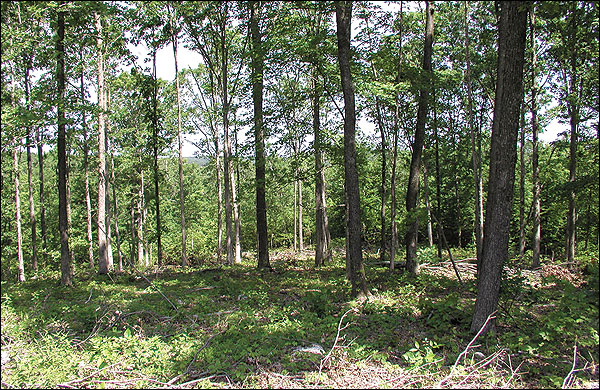
Figure 1
This stand of oaks in Bollinger County was thinned to improve growth and enhance habitat for wild turkey.
 Figure 2
Figure 2
Acorns, a staple product of oak forests, are eaten by many wildlife species.
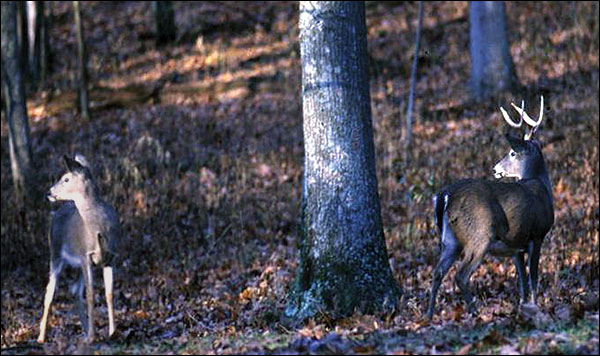
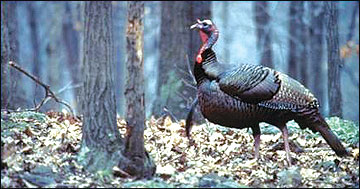 Figure 3
Figure 3
Oaks provide food and cover for numerous wildlife species, including white-tailed deer (top) and wild turkeys (bottom).
Acorn production basics
Oaks have female and male flowers on the same tree, but wind pollination ensures cross-breeding among neighboring trees. Male flowers are the pollen-bearing stamens on catkins; female flowers are the short, rounded to pointed spikes on the leaf axils (Figure 4). The resulting acorns are produced near the ends of twigs within the tree's crown. Oaks with crowns that are fully exposed to sunlight — that is, those trees that are dominant or co-dominant in the stand — produce more acorns than trees with crowns that are totally or partially shaded.
Oaks can produce viable hybrids that are capable of producing acorns. Individual oak trees usually take about 30 years before they produce acorns. Mast crops are extremely variable. The variability in acorn production is often a result of poor pollination, late spring frosts or drought. Late in the season, acorn weevils can also be a factor. In addition, individual trees will be good, moderate or poor acorn-producers and may have genetic differences that affect their reproductive maturity.
Although potential acorn production during any given year is difficult to predict, larger-diameter trees with larger crowns generally produce more acorns than smaller-diameter trees with smaller crowns in the canopy. However, in some species, acorn production will begin to decline after the tree reaches a threshold diameter-size.
 Figure 4
Figure 4
Oak flowers: the pollen producing catkins (top) and the short, rounded spikes on the leaf axils (bottom).
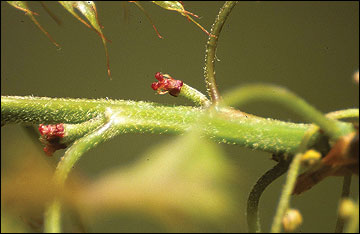
Differences among and within species
Nineteen species — and numerous hybrids — of oaks are found in Missouri. These species are divided into two groups: the red (or black) oak species and the white oak species (Table 1).
Acorns of trees in the red oak group take 15 months, two growing seasons, to mature and are bitter because they are high in tannic acid. White oak acorns are less bitter and mature in three months, one growing season (Figure 5). Each fall, trees in the red oak group will have a combination of small, immature acorns on the current year's growth and mature acorns on the previous year's growth. Thus, species in the red oak group can provide an acorn crop in years with a late spring freeze that might have destroyed the white oak acorn crop. However, in both groups, acorn production remains very unpredictable from year to year. Research has shown that, on average, most species produce a good crop of acorns only one year out of three or four.
Some oak species are inherently better acorn-producers than others, and these different species will tend to produce a good acorn crop in different years. Environmental factors, such as a late spring frost or summer drought, can contribute to the cyclic nature of unfavorable acorn production during any particular year.
Within a species, individual trees will often have traits that allow them to produce more acorns than others, and the time period that acorns become available, or drop, can vary. Generally, when one tree in the white oak group produces well, all the potential acorn-producing trees in that population of white oaks will also tend to produce well. In contrast, within the red oak group, some trees yield well within a given year while others may not. In addition, only a relatively small percentage of the trees within a stand will have the capability to produce an abundant supply of acorns during a given year. Research has shown that among white oaks, only about 30 percent of large, healthy trees produced any acorns even during years of good production. Research has also shown that the trees that produce an abundance of acorns can be identified and managed to increase mast production.
Oaks are attacked by a variety of insects, so only a few acorns actually germinate and survive to become seedlings or young trees. As with other traits, however, within the same species some trees will be resistant to insect infestation while others will be severely impacted.
 Figure 5
Figure 5
Acorns from white oaks (top) mature in three months and are less bitter than red oak acorns (bottom), which take 15 months to mature. Acorns from both groups provide important foods for wildlife.
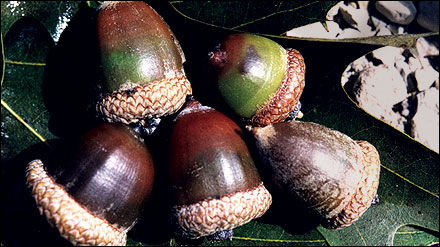
Table 1
Oak species in Missouri.
| Common name | Scientific name |
|---|---|
| White oak group | |
| White oak | Quercus alba |
| Post oak | Quercus stellata |
| Burr oak | Quercus macrocarpa |
| Swamp white oak | Quercus bicolor |
| Overcup oak | Quercus lyrata |
| Chinkapin oak | Quercus muehlenbergii |
| Swamp chestnut oak | Quercus michauxii |
| Red oak group | |
| Northern red oak | Quercus rubra |
| Black oak | Quercus velutina |
| Blackjack oak | Quercus marilandica |
| Scarlet oak | Quercus coccinea |
| Pin oak | Quercus palustris |
| Southern red oak | Quercus falcata |
| Cherrybark oak | Quercus pagoda |
| Nuttall oak | Quercus texana |
| Shingle oak | Quercus imbricaria |
| Willow oak | Quercus phellos |
| Water oak | Quercus nigra |
| Shumard oak | Quercus shumardii |
Refer to the Missouri Department of Conservation's online field guide, for more information and the occurrence of each species across the state.
Management techniques
The only way to know for sure which trees are the best producers is to check the acorn production of individual trees. You can evaluate trees for acorn production using binoculars in September or by simply noting which trees produce acorns while scouting or hunting during the fall.
The following techniques can be used to enhance acorn production on individual trees within a forest or woodland with established stands of oaks.
When walking through your woodlot, note the trees that seem to produce in an "off" year. These trees, will likely yield the most acorns over the long run. These trees should be retained and favored by any management practice you implement.
Before conducting a timber stand improvement (TSI) practice or a first thinning, identify and retain the best acorn-producers within the stand. The ideal way to identify the trees to retain is to observe the trees and keep records of their acorn production for five years or more. If this time frame isn't practical, you can get a rough estimate of the acorn-production capacity of individual trees by observing the trees during a single year in which a good acorn crop occurred. However, keep in mind that many of the good producers within the red oak group may be overlooked during a single year as the individual trees of those species may not all produce a good crop of acorns during the same year.
Table 2 provides criteria for identifying trees that are optimal acorn-producers. The best time to observe and rank trees for their potential acorn production is from mid- to late August before acorns are consumed by a variety of insects and wildlife. Acorns can be easily seen through binoculars on bright, sunny days when they are silhouetted against the sky (Figure 6).
Conduct thinning operations around the trees that have been identified as the best acorn-producers so as to expose their crowns to full sunlight on all sides (Figure 7). Sunlight exposure will facilitate the expansion and density of branches within the crown. Increasing the density of branches within the crown also increases the potential production of acorns per unit area of the crown. Dominant and codominant oaks within the stand will generally be the most efficient acorn-producers (Figure 8). However, depending on the site and quality of the trees, it may be desirable to thin out certain codominant trees in the stand during a TSI practice to give the dominant trees more space and opportunity to grow.
Area-wide thinning is generally not a good method for increasing acorn production on individual trees as a maximum of about 20 good seed-producers per acre will likely occur even in stands that are predominantly composed of oaks.
During TSI and thinning operations, be sure to retain a mixture of both red and white oak species to minimize the impacts of the large year-to-year fluctuations in acorn production that may occur. The goal should be to keep about 50 to 60 percent of the trees in oaks, evenly divided between red and white oak groups. Other optimal ratios include 2-to-1 or 3-to-1 red oaks to white oaks. These ratios are recommended to prevent a total mast failure in a given year while maximizing the total mast production in the stand. In addition, if you are managing your timber crop using an uneven-aged system, then removing no more than one-third of the stand's stocking during a TSI or tree harvest operation is advised.
When determining which trees to retain, consider the tree diameter of maximum acorn production of the predominant species within each stand. Although not all oak species exhibit well-defined diameter-related peaks in acorn production, several do. For example, acorn production in a northern red oak generally peaks when the tree diameter at breast height (dbh) (4.5 feet above the ground) reaches 20 inches and then gradually declines as the tree grows larger (Figure 9). In contrast, acorn production in white oaks peaks at about 26 inches dbh.
Table 2
A ranking of acorn production potential for individual trees by red and white oak groups.
| Ranking | Average number of acorns per branch | |
|---|---|---|
| White oak group | Red oak group | |
| Excellent | 18+ | 24+ |
| Good | 12–17 | 16–23 |
| Fair | 6–11 | 8–15 |
| Poor | 0–5 | 0–7 |
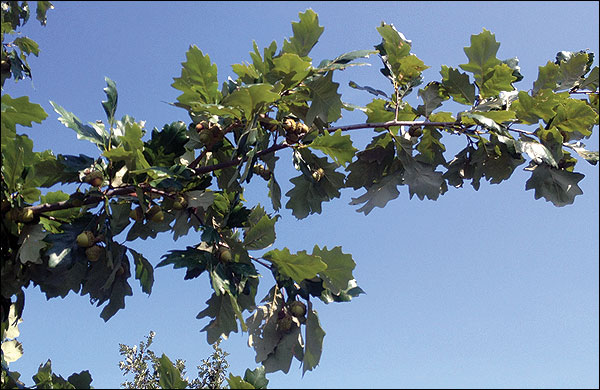
Figure 6
One way to identify good acorn-producers is to view trees through binoculars on a bright, sunny day when acorns are silhouetted against the sky.
 Figure 7
Figure 7
These oaks were the dominant trees in the canopy and were retained after a timber stand improvement practice, which encourages increased growth and acorn production.
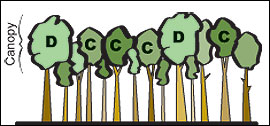 Figure 8
Figure 8
Dominant (D) and codominant (C) trees have larger crowns and get more sunlight than other trees in the stand, and are therefore generally better acorn-producers.
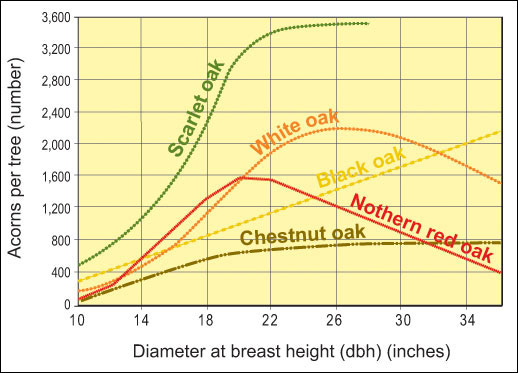 Figure 9
Figure 9
Average acorn production of trees in relation to their diameter at breast height (dbh). (Based on seven years of data collected from trees in the southern Appalachian Mountains.)
Conclusion
Woodland and forest stands that contain a diversity of hard mast–producing trees (red and white oaks, hickories, walnut) and soft mast species (dogwood, black gum, blackberry) provide important food sources and habitats for numerous wildlife species. Acorns are an especially important food for many species, so conducting forest management practices that favor oaks in a stand of hardwoods can benefit them. Implementation of management techniques to identify and retain those oaks that are the optimal producers in the stand is important when your goal is to improve habitat on your property for a diversity of wildlife species.
Be sure to contact MU Extension, a Missouri Department of Conservation private land conservationist, or a forestry professional for additional information and technical help in managing your forest and woodland for wildlife objectives.
Additional information
- Christisen, D.M., and W.H. Kearby. 1984. Mast measurement and production in Missouri (with special reference to acorns). Terrestrial series, 13. Jefferson City: Missouri Department of Conservation.
- Johnson, Paul S. 1994. How to manage oak forests for acorn production. North Central Forest Experiment Station Technical Brief TB-NC-1. Washington, D.C.: U.S. Department of Agriculture Forest Service.
- Sharp, W.M. 1958. Evaluating mast yields in the oaks. Agricultural Experiment Station Bulletin 635. University Park: Pennsylvania State University.
Photo credits: University of Missouri: Mark Coggeshall, Robert Pierce, John Dwyer and Hank Stelzer; Missouri Department of Conservation; and Bugwood. org: David Lee, United States; Bill Cook, Michigan State University; and Paul Wray, Iowa State University.
Content reviewed in November 2017 by Hank Stelzer.